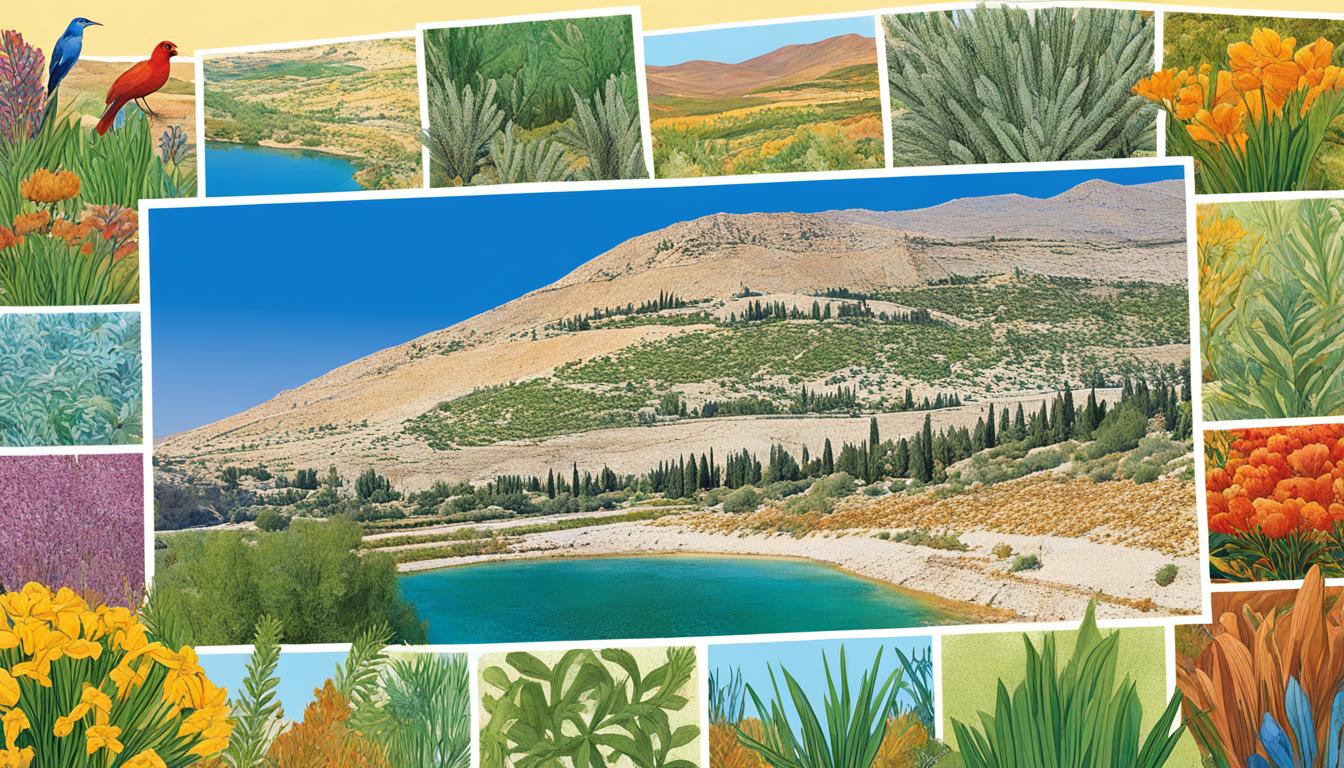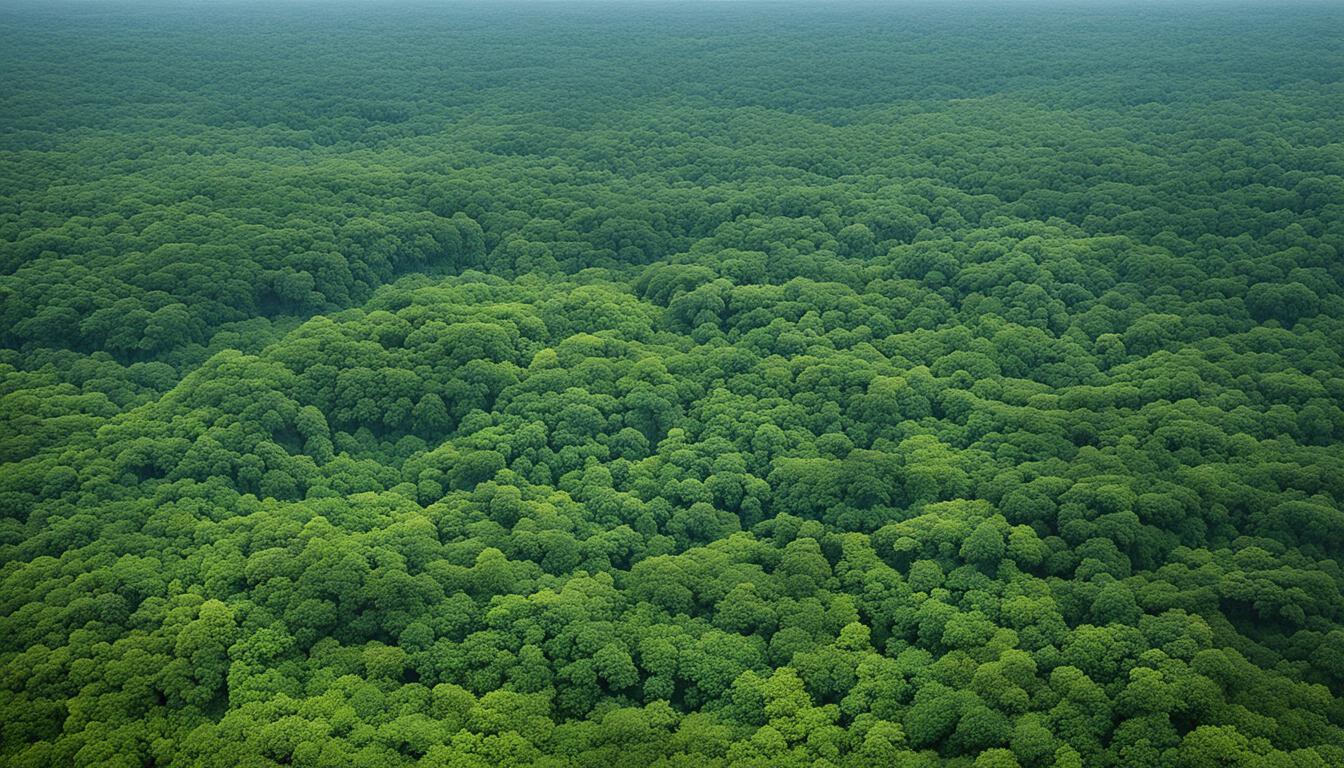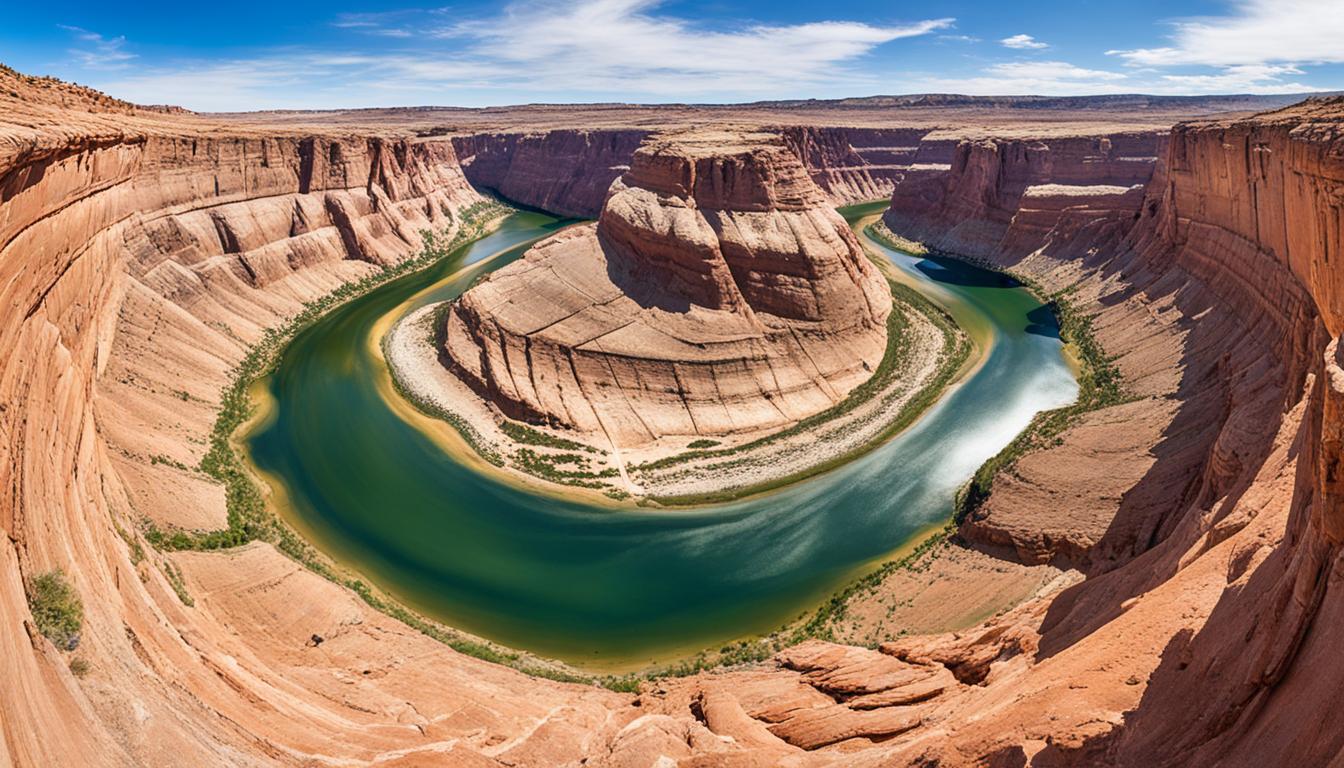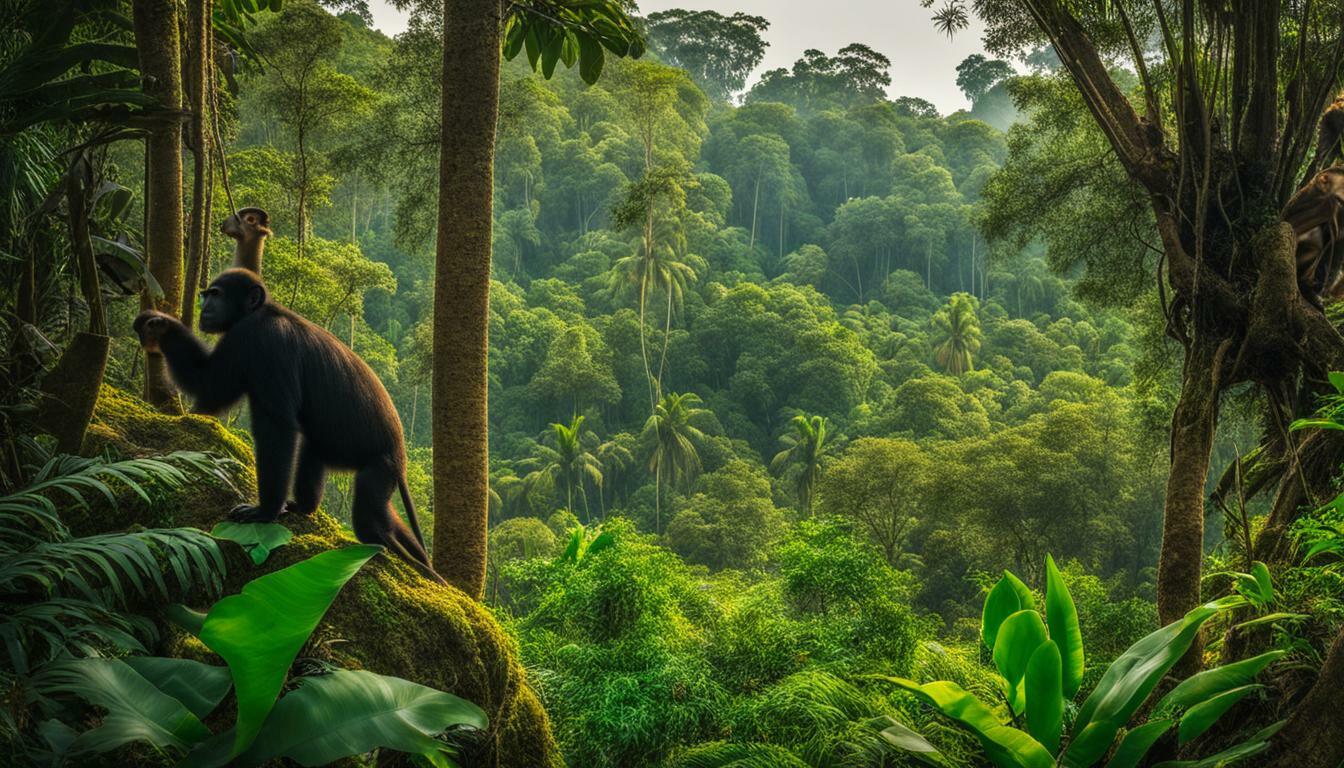Jamaica Biodiversity: Animal and Plant Species and What Is Under Threat
Welcome to an exploration of Jamaica’s remarkable biodiversity. This Caribbean island boasts a vibrant array of animal and plant species, making it a true natural treasure. From unique plant life to endemic animal species, Jamaica’s biodiversity is both diverse and delicate. However, this rich tapestry of life faces numerous threats that jeopardize its survival. Join us as we delve into the wonders of Jamaica’s natural world and uncover the challenges that it confronts.
Key Takeaways:
- The biodiversity of Jamaica encompasses a wide range of animal and plant species.
- Jamaica is ranked fifth in the world for plant endemism and has a high level of endemism for animal species.
- Threats to Jamaica’s biodiversity include habitat loss, over-exploitation, invasive alien species, weak law enforcement, pollution, and climate change.
Flora and Fauna of Jamaica Biodiversity
Jamaica is renowned for its vibrant and diverse flora and fauna. The country’s tropical ecosystems provide a thriving habitat for a remarkable array of species, making it a biodiversity hotspot.
In terms of plant life, Jamaica is home to over 3,500 different species, with an impressive 900 of them being endemic to the island. This means that they can only be found in Jamaica, making them incredibly unique and special. The lush forests and varied landscapes of the country support a wide range of plants, from towering trees to delicate flowers.
The fauna of Jamaica is equally impressive. The island is teeming with bird and reptile species, many of which are endemic to the country. Among the avian residents of Jamaica are 31 endemic bird species, each with its own distinct beauty and charm. The reptiles of Jamaica also showcase remarkable diversity, with several endemic species calling the island home.
“Jamaica’s biodiversity extends far beyond its shores, encompassing its abundant marine ecosystems. These tropical waters support an astonishing array of marine life, including fish, corals, mollusks, turtles, whales, dolphins, and manatees. From the colourful corals to the majestic sea creatures, the underwater world of Jamaica is a sight to behold.”
The Endemic Species of Jamaica
The presence of endemic species in Jamaica adds a layer of significance to its biodiversity. These species have evolved over time and adapted to the unique conditions of the island. Not only do they contribute to the ecological richness of Jamaica, but they also play a vital role in maintaining the balance of its ecosystems.
It is estimated that Jamaica is home to numerous endemic reptile species, each with its own niche in the intricate web of life. These reptiles, such as the Jamaican boa and the Jamaican iguana, are found nowhere else in the world, making their conservation of paramount importance.
The endemic bird species of Jamaica also hold a special place in the heart of the country’s biodiversity. These feathered wonders, including the Jamaican tody and the Jamaican lizard cuckoo, inspire awe with their vivid plumage and enchanting songs.
Exploring Jamaica’s Tropical Ecosystems
To truly appreciate the flora and fauna of Jamaica, one must immerse themselves in its tropical ecosystems. From the lush rainforests to the vibrant coral reefs, these ecosystems provide a rich and diverse habitat for an astonishing variety of species.
The rugged mountains and verdant valleys of Jamaica are home to an abundance of plant life. In the heart of the Blue Mountains lies the world-famous Blue Mountain coffee, sourced from the carefully cultivated coffee plantations. Jamaica’s tropical forests are also teeming with a myriad of plant species, forming a lush green tapestry that blankets the landscape.
The marine ecosystems of Jamaica are equally captivating. The crystal-clear waters are a haven for an incredible diversity of fish and coral species. Snorkelers and divers are treated to an underwater spectacle, where vibrant fish dart among the intricate coral formations and graceful turtles glide through the sea.
A Glimpse into Jamaica’s Biodiversity
The extraordinary flora and fauna of Jamaica provide a glimpse into the awe-inspiring beauty and complexity of its biodiversity. From endemic species that are found nowhere else in the world to the delicate balance of its tropical ecosystems, Jamaica’s natural treasures are a testament to the wonders of nature.
As we delve further into the intricate tapestry of Jamaica’s biodiversity, we will explore the challenges it faces and the tireless efforts being made to preserve and protect its unique flora and fauna. By working together, we can ensure a sustainable future for Jamaica’s biodiversity and the ecosystems that depend on it.
| Flora and Fauna | Endemic Species | Tropical Ecosystems |
|---|---|---|
| Over 3,500 plant species | 900 endemic plant species | Rich rainforests and vibrant coral reefs |
| 31 endemic bird species | Endemic reptile species | Marine diversity: fish, corals, mollusks, turtles, whales, dolphins, and manatees |
Endangered and Threatened Species in Jamaica
Jamaica is home to several endangered and threatened species. One such example is the Jamaican iguana, which is listed as critically endangered on the IUCN Red List. The population of this species is estimated to be around 200 individuals and is limited to the limestone forests of Hillshire. Other endangered and threatened species in Jamaica include bats, birds, frogs, and butterflies. Conservation efforts are underway to protect and restore the habitats of these species, and to engage local communities in conservation initiatives.
| Endangered Species | Threatened Species | Conservation Efforts |
|---|---|---|
| Jamaican iguana | Bats | Protect and restore habitats |
| Birds | Engage local communities | |
| Frogs | ||
| Butterflies |
Conservation efforts in Jamaica focus on preserving the unique biodiversity and habitats that are essential for the survival of endangered and threatened species. Through initiatives such as habitat restoration and protection, these efforts aim to create sustainable environments that support the growth and recovery of these species. Additionally, engaging local communities in conservation activities raises awareness about the importance of these species and promotes coexistence with wildlife.
Threats to Jamaica’s Biodiversity
Jamaica faces multiple challenges that threaten its rich biodiversity. These threats have the potential to disrupt delicate ecosystems and jeopardize the survival of various plant and animal species. The following factors pose significant risks to Jamaica’s biodiversity:
- Habitat Loss: The destruction of natural habitats through deforestation and urban sprawl is a major concern. These activities result in the loss of crucial ecosystems that support diverse plant and animal life.
- Over-exploitation: Unsustainable fishing and agriculture practices exert significant pressure on Jamaica’s ecosystems. Over-harvesting of resources can disrupt the balance of these environments, leading to the decline of certain species.
- Invasive Alien Species: The introduction of non-native species can have a detrimental impact on native flora and fauna. Invasive alien species often outcompete native species for resources, leading to population declines and biodiversity loss.
- Pollution: Pollution, including water pollution and inadequate waste management, poses a threat to Jamaica’s biodiversity. Contaminated waterways and improper solid waste disposal can harm aquatic life and degrade habitats.
- Climate Change: The effects of climate change, such as rising temperatures, changing rainfall patterns, and extreme weather events, have profound impacts on Jamaica’s biodiversity. These changes can disrupt ecosystems, alter habitats, and threaten the survival of vulnerable species.
To fully understand the gravity of these threats, it is crucial to examine each one’s implications carefully. Only through a comprehensive understanding can we develop effective strategies to mitigate these risks and protect Jamaica’s valuable biodiversity.

Conservation Efforts in Jamaica
Jamaica recognizes the importance of conserving its rich biodiversity and has taken proactive measures to protect and preserve its natural resources. Conservation efforts in Jamaica aim to ensure the sustainability of ecosystems, promote the establishment of protected areas, and integrate sustainable development practices into various sectors.
Jamaica’s Protected Areas
One of the key strategies employed by Jamaica to conserve its biodiversity is the establishment of protected areas. These areas serve as havens for important habitats and species, safeguarding them from threats such as habitat loss and overexploitation. Jamaica has designated several national parks and marine protected areas, each contributing to the overall conservation efforts.
“Protected areas play a crucial role in preserving biodiversity and promoting ecosystem health. By designating these areas, Jamaica is taking proactive steps towards ensuring the long-term survival of its unique flora and fauna.”
These protected areas not only serve as refuges for endangered species but also provide opportunities for research, education, and ecotourism. They allow visitors to appreciate the beauty and richness of Jamaica’s natural landscapes while raising awareness about the importance of conservation.
Sustainable Development Practices
Jamaica recognizes the need for a balanced approach to development that integrates conservation with economic growth. The country has embraced sustainable development practices that consider the value of its natural resources and aim to minimize environmental impacts.
Through sustainable development initiatives, Jamaica aims to improve resource management, enhance ecosystem services, and support local communities. The government, non-governmental organizations (NGOs), and local communities collaborate to implement projects that promote sustainable agriculture, responsible tourism, and eco-friendly practices in industries such as fishing and forestry.
Collaboration and Awareness
Conservation efforts in Jamaica rely on collaboration between government agencies, NGOs, and local communities. Through partnerships and community engagement, stakeholders work together to implement conservation measures, raise awareness about the importance of preserving biodiversity, and provide training and capacity-building opportunities.
“By involving communities in conservation efforts, Jamaica fosters a sense of ownership and responsibility, ensuring the long-term success of conservation initiatives and the sustainability of its natural resources.”
Education programs, outreach campaigns, and workshops are conducted to empower individuals and communities with knowledge about biodiversity, sustainable practices, and the benefits of conservation. These initiatives help create a culture of environmental stewardship and nurture a sense of pride in Jamaica’s unique natural heritage.
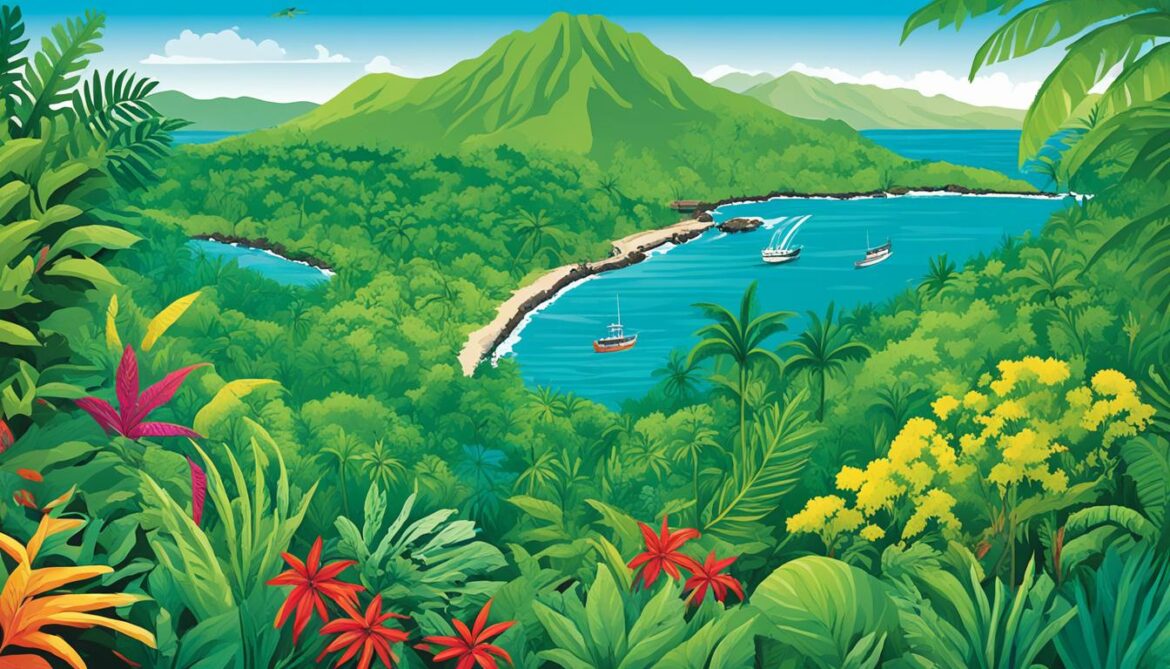
In conclusion, Jamaica’s commitment to conservation is evident through its establishment of protected areas, promotion of sustainable development practices, and engagement with communities. By safeguarding its biodiversity and integrating conservation into various sectors, Jamaica strives to ensure a sustainable future for its natural resources and the well-being of its people.
Enhancing Implementation of the Convention on Biological Diversity
Jamaica is committed to enhancing the implementation of the Convention on Biological Diversity through the development of its National Biodiversity Strategy and Action Plan (NBSAP). The NBSAP encompasses a range of projects and measures aimed at conserving biodiversity, promoting sustainable use of biological resources, enhancing resource management capacity, raising public awareness, and fostering regional cooperation. These efforts align with the Aichi Biodiversity Targets, a set of global goals designed to address the loss of biodiversity and ensure its sustainable use.
Aichi Biodiversity Targets: Driving Conservation Action
The Aichi Biodiversity Targets outline specific objectives that countries, including Jamaica, aim to achieve to safeguard biodiversity. These targets include increasing awareness of biodiversity values, promoting sustainable land and sea management, rehabilitating and restoring degraded ecosystems, addressing the impact of invasive alien species, and reducing pollution and other pressures on biodiversity.
Jamaica’s NBSAP plays a crucial role in achieving these targets by implementing effective measures and strategies. The country focuses on capacity-building, legislation, funding, coordination, and mainstreaming to support the successful implementation of the NBSAP and contribute to the global conservation agenda.
Implementing Measures: Key Steps towards Conservation
Jamaica has taken various measures to enhance the implementation of the NBSAP and achieve the Aichi Biodiversity Targets. These measures include:
- Establishing protected areas: Jamaica has designated and managed protected areas to conserve biodiversity-rich habitats, safeguard endemic species, and restore degraded ecosystems.
- Integrating biodiversity into decision-making processes: Jamaica seeks to mainstream biodiversity considerations into various sectors, policies, and development plans to ensure sustainable and biodiversity-friendly practices.
- Strengthening legislation and enforcement: Jamaica is focused on enacting and enforcing robust biodiversity laws and regulations, penalizing illegal activities that harm biodiversity, and promoting sustainable practices.
- Enhancing public awareness and participation: Jamaica actively engages with communities, educational institutions, and civil society organizations to raise awareness about the importance of biodiversity and its conservation.
- Facilitating scientific research and monitoring: Jamaica supports scientific studies and monitoring programs to better understand biodiversity patterns, assess conservation progress, and inform decision-making processes.
- Collaborating regionally and internationally: Jamaica fosters partnerships and cooperation with other countries, organizations, and initiatives to share knowledge, experiences, and best practices in biodiversity conservation.
“Successfully implementing the NBSAP and achieving the Aichi Biodiversity Targets requires a collaborative and multi-faceted approach,” says Dr. Jane Collins, Director of the Jamaican Institute of Environmental Sciences. “Through concerted efforts and effective implementation measures, Jamaica aims to protect its unique biodiversity for future generations.”
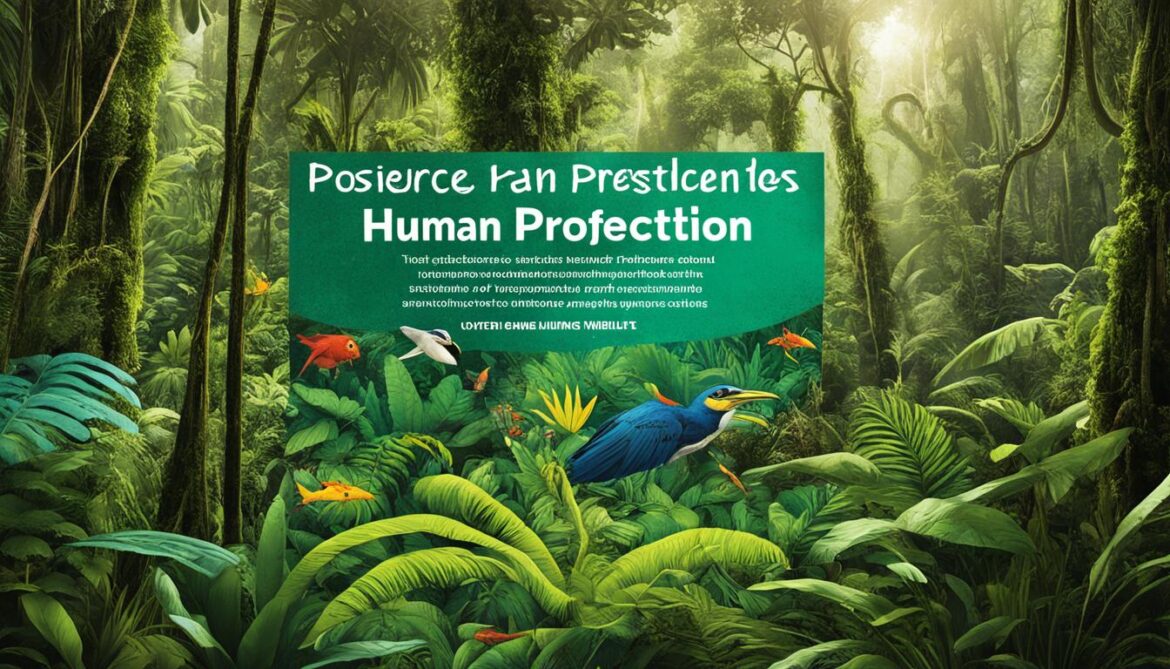
Marine Protection in Jamaica
As part of its commitment to marine protection, Jamaica is actively participating in the Caribbean Challenge Initiative (CCI). The CCI’s goal is to safeguard a minimum of 20 percent of the marine environment by 2020 and ensure the effective management of protected areas.
In line with this commitment, Jamaica has made significant progress in expanding its coverage of marine protected areas. The country has almost doubled its marine protected area coverage from 11 to 20 percent through the establishment of fish sanctuaries and the implementation of effective management practices.
One of the key focuses of Jamaica’s marine protection efforts is promoting sustainable fishing practices. By encouraging fishers to adopt sustainable fishing methods, such as responsible catch limits and gear restrictions, the aim is to strike a balance between conserving marine ecosystems and supporting the livelihoods of local fishing communities.
Habitat restoration is also a crucial aspect of Jamaica’s marine protection strategy. By rehabilitating degraded areas and creating artificial reefs, the country aims to enhance the resilience of marine habitats and promote the recovery of important species and ecosystems.
The Jamaican government and various stakeholders are actively working to raise awareness among fishers about the importance of conserving marine ecosystems. Education campaigns, workshops, and outreach programs are being conducted to promote a better understanding of the value of marine biodiversity and the long-term benefits of sustainable fishing practices.
“Our efforts in marine protection are not just about conserving natural resources; they are also about securing sustainable livelihoods for our fishers and preserving our cultural heritage,” said Dr. Jane Gibson, marine biologist and advisor to the Ministry of Environment and Climate Change.
The Caribbean Challenge Initiative (CCI)
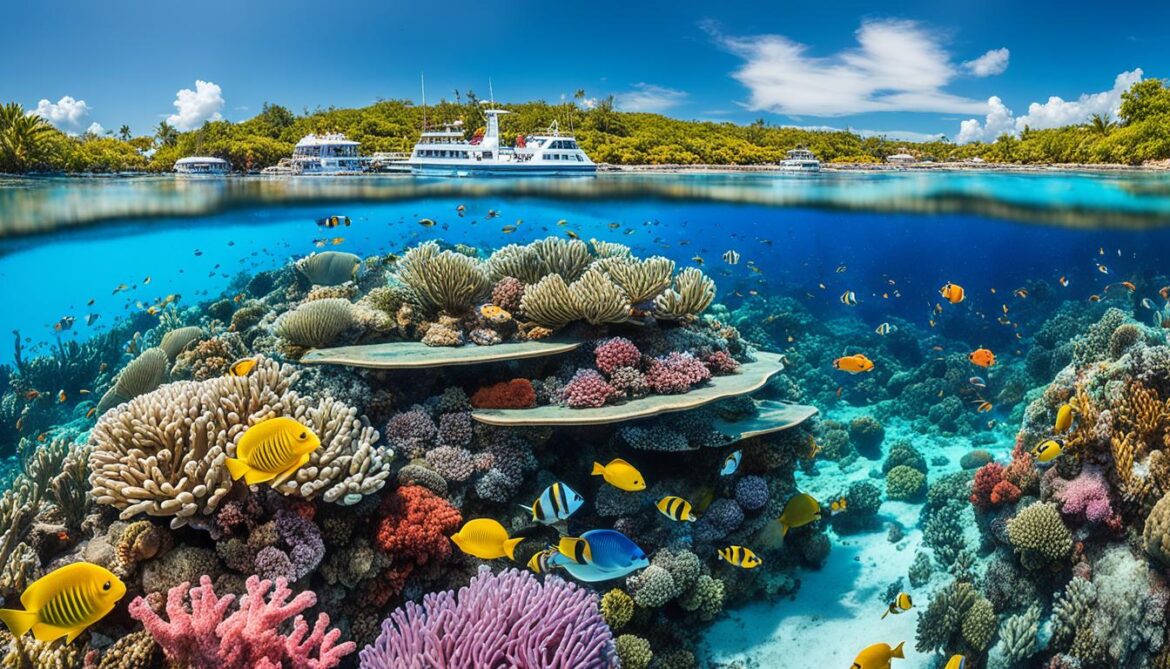
The Caribbean Challenge Initiative (CCI) is a regional collaboration aimed at promoting the conservation and sustainable use of coastal and marine resources throughout the Caribbean. Jamaica, along with other Caribbean nations, has made a commitment to the CCI to protect their marine environments and promote the sustainable development of coastal communities.
The CCI focuses on four key pillars: marine protected areas, climate change adaptation and resilience, sustainable financing, and regional coordination. By working together, Caribbean countries strive to achieve the conservation and sustainable management of their marine ecosystems.
The Importance of Marine Protected Areas
Marine protected areas (MPAs) play a vital role in ensuring the long-term health and sustainability of marine ecosystems. These designated areas provide refuge for a wide range of marine species, allowing them to breed, feed, and thrive without disturbance.
MPAs also help to preserve critical habitats such as coral reefs, mangroves, and seagrass beds, which are essential for supporting biodiversity and providing valuable ecosystem services. They act as “nurseries” for fish and other marine organisms, ensuring the replenishment of populations and supporting sustainable fishing practices. (https://www.wmpg.org)
Furthermore, MPAs contribute to the resilience of marine ecosystems in the face of climate change. By protecting crucial habitats and reducing stressors, such as overfishing and pollution, MPAs enhance the ability of marine ecosystems to adapt and withstand the impacts of a changing climate.
Freshwater Conservation in Jamaica
Jamaica recognizes the importance of preserving its water resources and has made significant investments in nature-based solutions to protect and restore them. With over 100 streams and rivers providing freshwater for various uses, safeguarding these valuable resources is crucial for the country.
Nature-based solutions play a key role in sustaining and filtering freshwater naturally. One such solution is reforesting lands surrounding water sources. By planting trees, Jamaica helps to reduce soil erosion, filter pollutants, and maintain a healthy water supply. Additionally, protecting critical areas like forests in the Blue Mountains and Cockpit Country contributes to the overall health of freshwater ecosystems.
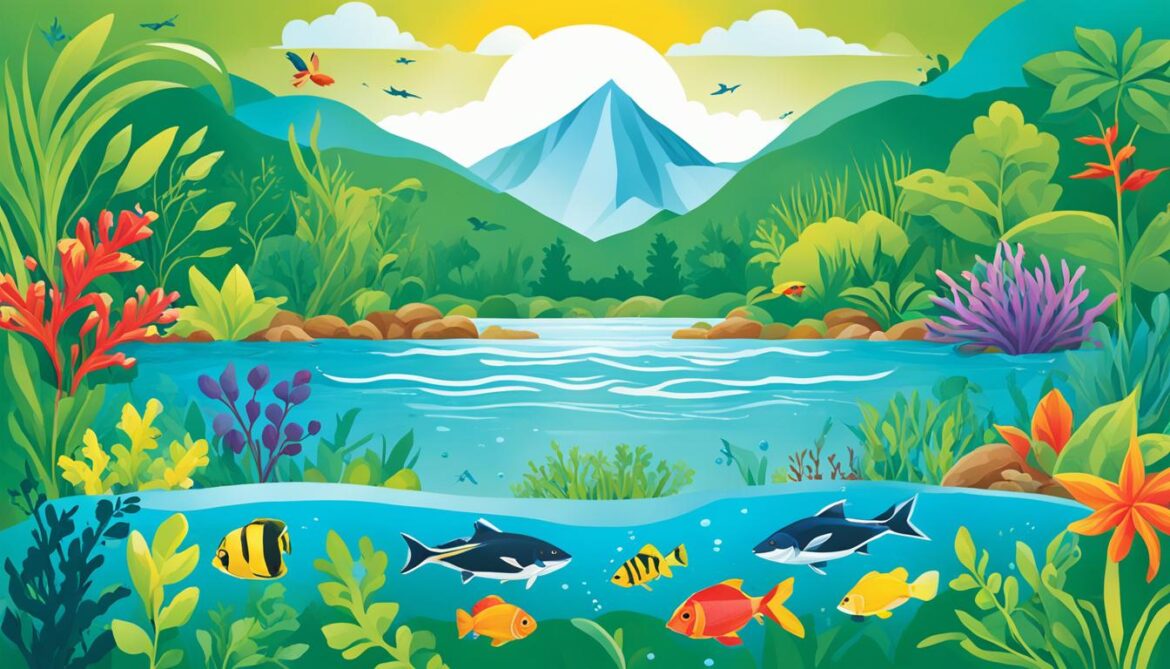
Jamaica is also exploring the establishment of a water fund to generate long-term funding for the protection and restoration of lands and forests surrounding water sources. This fund would provide financial support for the ongoing conservation efforts and ensure a sustainable future for Jamaica’s freshwater resources.
Overall, Jamaica’s commitment to freshwater conservation through nature-based solutions and the establishment of a water fund showcases its dedication to preserving this vital resource for future generations.
| Water Resources | Conservation Efforts |
|---|---|
| Over 100 streams and rivers | Nature-based solutions |
| Reforestation of lands surrounding water sources | |
| Protection of critical areas | |
| Establishment of a water fund for long-term protection and restoration |
Challenges and Opportunities in Climate Change Adaptation
Jamaica recognizes the challenges posed by climate change to its biodiversity and is working diligently to address them. The impact of climate change on Jamaica’s ecosystems and species is a growing concern. Rising temperatures, changing rainfall patterns, and increased frequency of extreme weather events are all having adverse effects on the delicate balance of these ecosystems.
However, one of the challenges faced by scientists and researchers in Jamaica is the limited availability of up-to-date inventory and data collection devices. This hinders the accurate understanding of climate change impacts and the development of effective adaptation strategies. Without comprehensive data, it becomes difficult to assess the situation and plan appropriate measures.
Nevertheless, efforts are underway to collect essential data and update baseline inventories of plant and animal species across the island. Through collaborative initiatives, such as the Caribbean Planning for Adaptation to Global Climate Change (CPACC), Jamaica is taking significant steps towards addressing the challenges of climate change. CPACC serves as a platform for knowledge sharing, capacity building, and collaborative action, encouraging regional cooperation in climate change adaptation.
An important aspect of climate change adaptation in Jamaica is the allocation of funding towards key areas. Adaptation funds are being utilized to replant forests, engage local communities, and improve data collection mechanisms. These resources are crucial in supporting informed decision-making and ensuring effective implementation of adaptation strategies.
“Climate change is a complex issue that requires a comprehensive approach. By investing in data collection, engaging in collaborative research, and promoting knowledge sharing, Jamaica is laying the foundation for effective climate change adaptation.” – Dr. Olivia Brown, Climate Scientist
The Importance of Ecosystem Management
Ecosystem management plays a critical role in climate change adaptation. By understanding the functioning and resilience of ecosystems, stakeholders can develop strategies to mitigate climate impacts and enhance adaptive capacity.
Effective ecosystem management involves preserving and restoring natural habitats, promoting sustainable land and water management practices, and conserving biodiversity. These measures can help ecosystems withstand the changing climatic conditions and maintain their valuable ecological services.
Moreover, ecosystem-based adaptation approaches offer multiple benefits, such as water regulation, carbon sequestration, and the provision of food and livelihoods for local communities. Investing in such approaches can contribute to sustainable development, ensuring a harmonious coexistence between human activities and the environment.
| Challenges in Climate Change Adaptation | Opportunities in Climate Change Adaptation |
|---|---|
|
|
| Ecosystem Management Challenges | Ecosystem Management Opportunities |
|
|
Climate change adaptation in Jamaica requires a multi-faceted approach. Adequate data collection, collaborative research, and effective ecosystem management are crucial in addressing climate change impacts and ensuring a sustainable future for Jamaica’s diverse ecosystems.
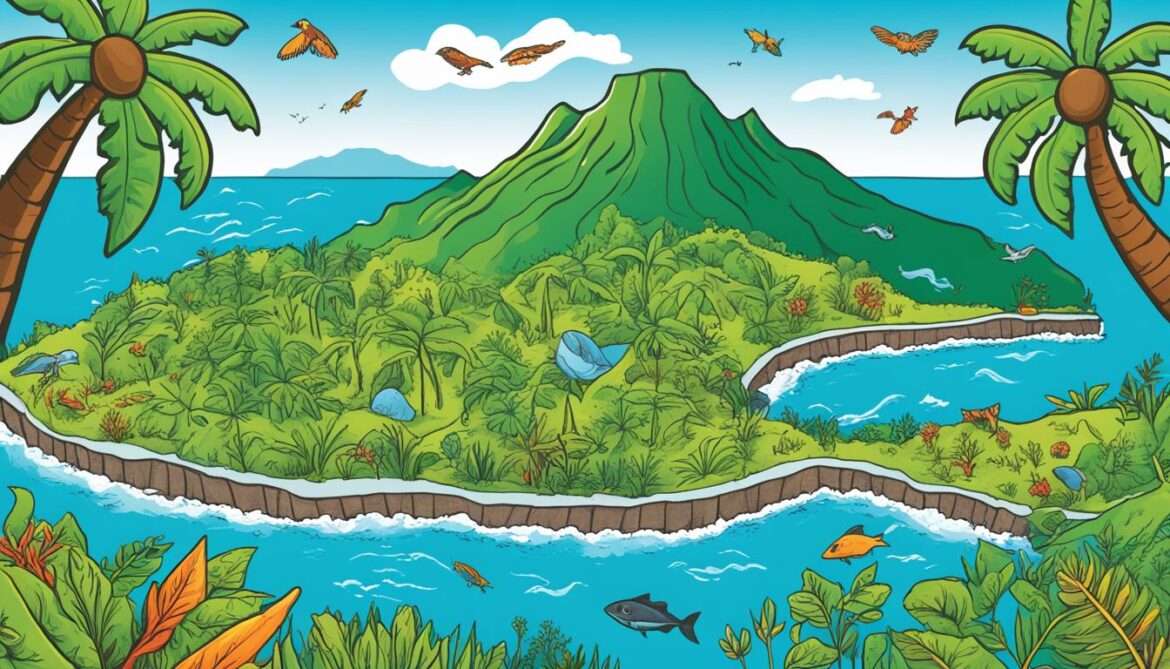
Collaboration and Engagement for Biodiversity Conservation
Biodiversity conservation in Jamaica heavily relies on collaboration and engagement with local communities. Efforts are underway to involve communities in the management and protection of natural resources, ensuring the long-term sustainability of the island’s unique ecosystems.
One important aspect of community involvement is providing training and education on sustainable practices. By equipping community members with the knowledge and skills to implement sustainable practices, they can actively contribute to the preservation of biodiversity. Education programmes focus on topics such as responsible resource management, waste reduction, and sustainable agriculture.
Building awareness of the value of biodiversity is also crucial in engaging local communities. Outreach campaigns, community-based platforms, and partnerships with government agencies, NGOs, and local organizations help raise awareness and promote conservation practices. By highlighting the inherent beauty and importance of Jamaica’s diverse flora and fauna, individuals are encouraged to actively participate in protecting and preserving their natural heritage.
“Engaging local communities in biodiversity conservation not only helps protect crucial ecosystems but also empowers individuals to take ownership of their natural surroundings.”
Recognizing that livelihoods often depend on natural resources, efforts have been made to find alternative income-generating opportunities that are compatible with sustainable practices. Community-led initiatives have been successful in developing eco-tourism, sustainable fisheries, and nature-based products, providing economic incentives for conservation while safeguarding the integrity of Jamaica’s ecosystems.
Promoting Sustainable Practices
The adoption of sustainable practices is key to preserving biodiversity in Jamaica. Through collaboration and community engagement, individuals are encouraged to incorporate sustainable practices into their daily lives.
- Practicing responsible waste management through recycling and reducing single-use plastics
- Conserving water resources through efficient usage and rainwater harvesting
- Supporting sustainable agriculture through organic farming techniques and agroforestry
- Protecting and restoring natural habitats through reforestation and habitat conservation efforts
By implementing these sustainable practices, individuals can minimize their environmental footprint, support the conservation of biodiversity, and contribute to the overall health of Jamaica’s ecosystems.
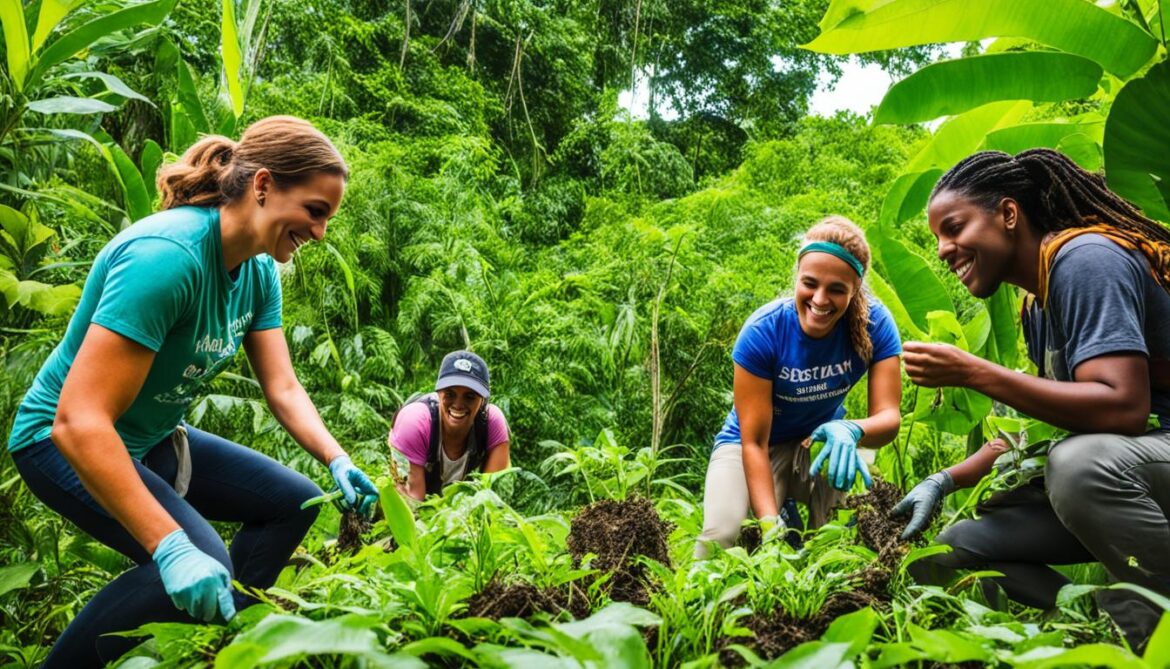
Community Empowerment and Collaboration
Community empowerment is an integral part of biodiversity conservation in Jamaica. By actively involving local communities in decision-making processes and fostering partnerships, a sense of ownership and responsibility is cultivated.
Collaboration between government agencies, NGOs, and local organizations is essential for the successful implementation of conservation initiatives. These partnerships ensure coordinated efforts, effective resource management, and the sharing of best practices. Engaging stakeholders at all levels allows for diverse perspectives, knowledge exchange, and a comprehensive approach to biodiversity conservation.
Benefits of Community Involvement
The involvement of local communities in biodiversity conservation serves multiple purposes:
| Benefits | Examples |
|---|---|
| Enhanced conservation practices | Community-led restoration projects and sustainable fishing practices |
| Inclusive decision-making | Community participation in protected area management committees |
| Raised awareness and sense of responsibility | Education programs on the importance of biodiversity and conservation |
| Sustainable livelihoods | Eco-tourism, sustainable agriculture, and nature-based product development |
| Long-term commitment | Community involvement ensures the continuity of conservation efforts |
By actively engaging communities, Jamaica is fostering a sense of stewardship, ensuring the protection of its unique biodiversity for future generations to enjoy.
Conclusion
Jamaica’s biodiversity is a valuable asset that requires protection. The country’s rich flora and fauna, including endemic species, contribute to its ecological diversity and support vital ecosystems. However, habitat loss, over-exploitation, invasive species, pollution, and climate change present significant challenges.
Jamaica is actively addressing these threats through conservation efforts, the establishment of protected areas, sustainable development practices, and community engagement. By implementing strategies that enhance biodiversity, Jamaica aims to secure a sustainable future for its natural resources and the communities that depend on them.
Through continued conservation efforts, Jamaica can preserve its diverse and unique wildlife, protect its rich ecosystems, and promote a sustainable future for generations to come.




